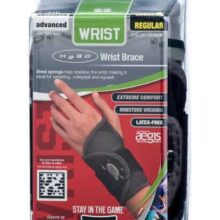Pro Hand Exerciser
Login For Health Care Pricing
The Pro hand Exerciser is suited for larger hands and has 5 colour coded resistance levels. It uses heavier tension than most other hand exercisers.
The CanDo® Pro® Hand Exerciser can isolate and strengthen fingers. In addition, it can help develop hand and forearm flexibility and coordination. It is more suitable for patients with larger hands.
This is a great accessory for sports medicine and athletic training. It has heavy tension and 5 progressively color-coded resistances together with soft finger pads for user comfort.
The Role of Hand Exercisers In Sports Medicine
Hand exercisers play a crucial role in sports medicine by helping athletes improve grip strength, dexterity, endurance, and overall hand function. Here’s a detailed overview of their role in sports medicine:
Grip Strength Improvement
- Hand exercisers are widely used to enhance grip strength, which is essential for athletes in sports such as tennis, golf, baseball, rock climbing, and weightlifting.
- Strong grip strength is crucial for maintaining control over sports equipment, such as racquets, clubs, bats, or barbells, and can significantly impact performance.
Injury Prevention and Rehabilitation
- Hand exercisers are employed in sports medicine to prevent hand injuries, such as strains, sprains, or repetitive stress injuries, by strengthening the muscles, tendons, and ligaments in the hands and forearms.
- They are also utilized in the rehabilitation of hand injuries to aid in the recovery process, promoting healing, restoring range of motion, and improving hand function.
Enhancing Dexterity and Coordination
- Athletes often rely on precise hand movements and fine motor skills in sports such as basketball, baseball, football, and gymnastics.
- Hand exercisers help improve dexterity, finger coordination, and hand-eye coordination, enhancing an athlete’s ability to manipulate objects, catch and throw balls, and perform intricate movements with precision.
Strengthening Forearm Muscles
- Hand exercisers not only target the muscles of the hands but also engage the muscles of the forearms, including the wrist flexors and extensors.
- Strengthening these muscles improves overall forearm strength and stability, which is vital for athletes in sports that involve repetitive arm movements, such as swimming, tennis, and volleyball.
Rehabilitation of Wrist Injuries
- Hand exercisers with specific wrist-focused exercises are beneficial for athletes recovering from wrist injuries, such as sprains, strains, or fractures.
- These exercisers help rebuild strength, stability, and flexibility in the wrist joint, facilitating the return to sports activities while reducing the risk of reinjury.
Increasing Endurance and Fatigue Resistance
- Athletes require sufficient hand and forearm endurance to maintain performance throughout training sessions and competitions.
- Hand exercisers are used to increase muscular endurance and fatigue resistance in the hands and forearms, allowing athletes to sustain grip strength and control over prolonged periods.
Warm-Up and Recovery Tool
- Hand exercisers are utilized as part of warm-up routines to prepare the hands and forearms for physical activity by increasing blood flow, flexibility, and neuromuscular activation.
- They also serve as a recovery tool, aiding in the alleviation of post-exercise muscle soreness and stiffness in the hands and forearms.
In summary, hand exercisers play a multifaceted role in sports medicine, addressing various aspects of hand and forearm strength, function, and injury prevention. They are valuable tools for athletes of all levels and disciplines, helping them optimize performance, prevent injuries, and expedite rehabilitation when injuries occur.








Commentaires
Il n'y a pas encore de commentaires